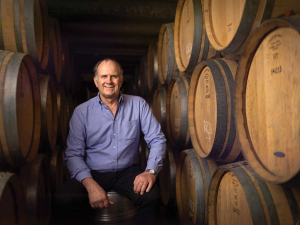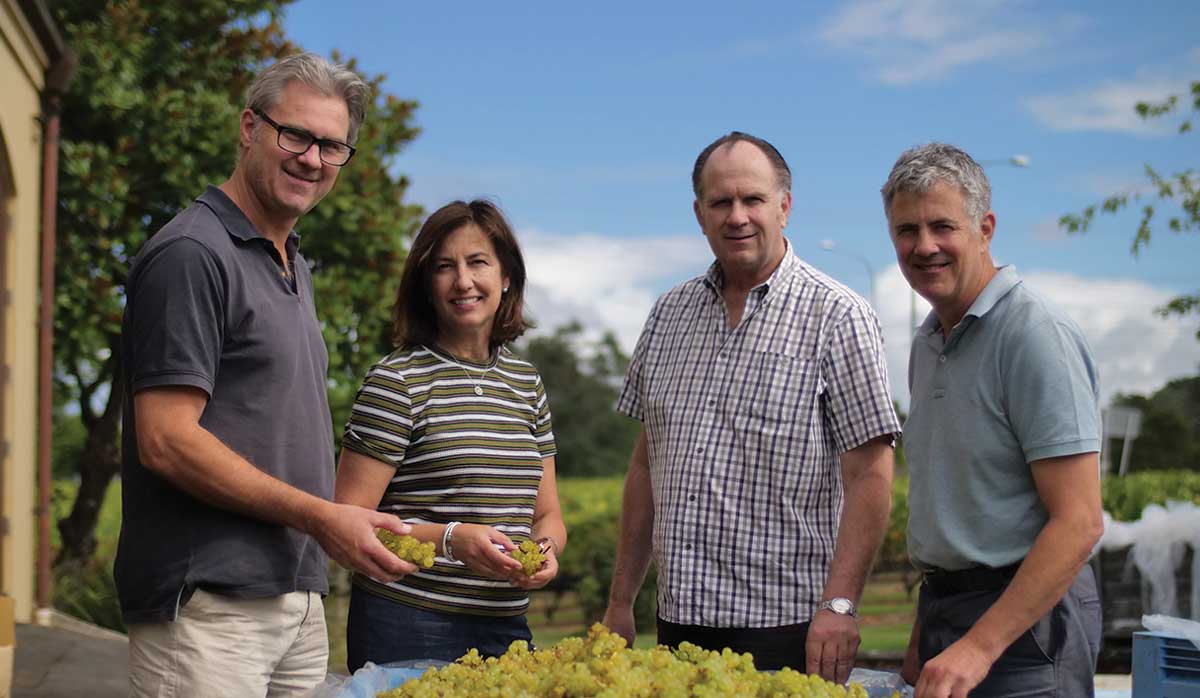Haere Ra 2025: Tāmaki Makaurau, Auckland
Kumeu River Winemaker Michael Brajkovich reflects on the year, including the loss of industry icons Peter Babich, Tim Finn and Dr Richard Smart.
 NZW Fellow Michael Brajkovich MW: “We never dreamed then we would have the kind of success we have had.”
NZW Fellow Michael Brajkovich MW: “We never dreamed then we would have the kind of success we have had.”
For services to winemaking
Maté Brajkovich was 12 years old when he moved to New Zealand in 1937, bringing with him a heritage of winemaking from his village in Croatia.
His son Michael was the same age when he decided he would become a winemaker, carrying on the legacy of his family's West Auckland vineyard and winery. "I think mum sat me down and said, 'look you have everything here'", Michael says more than 50 years on, having forged an extraordinary global reputation for Kumeu River Wines.
Michael's academic bent, considered intent, and global perspective have been hallmarks of his winemaking success, as the Dux of Roseworthy College in 1981, New Zealand's first Master of Wine in 1989, Chair of Judges at both the Air New Zealand Wine Awards and the Royal Adelaide Wine Show, and the 2024 Winemakers' Winemaker, presented by the Institute of Masters of Wine and the Drinks Business.
It's also seen him readily adapt over the decades, including jettisoning a Merlot dream when Auckland's weather proved problematic, eschewing yeast inoculation in the 1980s to produce Burgundy-inspired Chardonnay, and moving entirely to screwcap in 2001 to protect the quality of his wines. "It is a very New Zealand thing, that if something is not working quite right, we have the ability to change quickly and move on," Michael says.
A 2015 comparative tasting with Burgundy wines in London saw critics and wine writers put Kumeu River's Maté's, Coddington, Hunting Hill and Estate Chardonnays above a range of Premier Cru and top Village Burgundies, except for one, which was deemed first equal. That result, along with glowing reviews from the likes of Jancis Robinson and James Suckling, mean Kumeu River wines are on allocation in markets around the world.
"He has got to be our most respected Chardonnay producer," says New Zealand Winegrowers (NZW) Board Chair Clive Jones on the announcement of Michael as a 2024 NZW Fellow, calling him "a direct or indirect mentor to most premium Chardonnay producers in the country". Larry McKenna has long worn the moniker of the Prince of Pinot, Clive adds. "Is Michael the King of Chardonnay?"
Multigenerational family business
Michael is in Croatia when we talk, on the eve of a visit to Živogošće, the coastal town his grandparents Mick and Katé grew up in, working small plots of productive land. "Like everyone in the village, if you had a few vines, you made wine. Always a very good source of calories, that you could store for the rest of the year. For my father, who was 12 years old when they came to New Zealand, it was the basis rom which he started to make wine, and in particular red wine." Maté, who was always a "forward thinker", would go on to learn a lot more in New Zealand, including from Dalmatian colleagues in Henderson and his good friends Alex Corban, Tom McDonald and Peter Hubscher. "But the basics always went back to what was learned by my grandparents in the old country," Michael says.
The Brajkovich family worked tirelessly when they arrived, first in the gum fields up north, and then in Henderson, taking jobs in local vineyards and orchards. "It's the same immigrant story across all of New Zealand. They worked really hard." By 1944 they had saved the £200 deposit for their Kumeu block, where they milked cows and grew grapes, strawberries and pumpkins. Mick died in 1949, but by the mid-1950s Maté and Katé had paid off the mortgage, while Maté grew the focus on San Marino Vineyards. He met his wife Melba in 1957, and in 1960 Michael arrived, followed by Marijana, Milan and Paul, all of whom worked in the winery from a young age, and remain with Kumeu River today.
Maté would occasionally stand a three-year-old Michael on a box in the winery, so he could reach the switch to the pump. "He'd call out to me to start or stop the pump. I can still remember being extremely bored." But Michael and his siblings learned a lot in their early years, in the winery and bottling line, making up cartons, and helping sell wine on Saturdays, when Aucklanders would drive out west for eggs, fruit, vegetables and wine. “We used to sell 90% of the production of the winery through the shop.”
Back then San Marino was mostly focused on fortified wines, but Maté’s Kumeu Red Dry had also gained “quite a reputation”, especially with WWII soldiers who had returned to New Zealand with a taste for that style, and for the vermouth he made on the side. By the 1970s San Marino was moving to table wines, as Müller-Thurgau gained popularity.
Then in 1972 Michael decided he would become a winemaker, focusing on sciences at high school, along with French, to ensure he could connect with a country he still deemed the “epitome” of winemaking. The same year Maté travelled across South Australia, visiting wineries and spending time at Roseworthy Agricultural College. “I still have the cassette tapes he had recorded each day,” Michael says, reflecting on his father’s excitement at the possibility his son might attend the college. Maté only had a primary school education, and he and Melba, who had studied teaching, gave their four children a “great work ethic” and a steady focus on the importance of education, Michael says. “It was, and still is, really high on the list of things – do well at school and go on to university. And all of us did.”
In 1981 Michael graduated from Roseworthy and joined the family business, nurturing dreams of Merlot, fuelled by the purchase of a Corbans Merlot vineyard. That focus saw him work with Château Pétrus in Bordeaux, producer of “the most famous and the best Merlot in the world”, he says. “What a great opportunity. I pinch myself even now. How did that happen?” But Merlot struggled to ripen in Auckland, while Chardonnay proved itself every year, so they swiftly changed tack. Maté had planted Mendoza Chardonnay in the 1960s, but plantings in the early 1980s gave them access to newer clones and rootstocks, while the 1986 government vine pull enabled them to adapt. “We planted better varieties using better trellising design and making wine in a better way,” Michael says.
In 1984 he made a Merlot without inoculating with yeast, inspired by wild ferments he’d worked with in France. “We didn’t tell anybody we were doing it, because we thought people would think we were nuts.” Despite the success, with better texture, mouthfeel, and richness on the palate, he was reluctant to progress to the more delicate whites, until his brother Milan and Cellar Master Nigel Tibbits urged him to continue. “In 1986 we let the fermentations rip, and we haven’t looked back”. The Burgundy-influenced Chardonnays, featuring indigenous yeasts, extended lees ageing, and malolactic fermentation, changed the face of the company, renamed Kumeu River Wines in 1986. “But we never dreamed then we would have the kind of success we have had.”
Winemaker James Healy, whose groundbreaking Chardonnay made its mark on Cloudy Bay and Dog Point Vineyards for 30 years, had his first wine job at Corbans in Auckland in the early 1980s. There was a lot going on in wine in West Auckland back then, James says, recalling occasional drinks in the back of San Marino’s winery, where Maté Brajkovich held court. When Michael returned from Roseworthy, they struck up a friendship, and James watched with interest as Kumeu started to drop inoculation. Michael had a profound effect on New Zealand winemaking, but “he’s very unassuming and modest”, says James, who joined Cloudy Bay in 1991, and immediately pushed for wild Chardonnay ferments, followed by Sauvignon Blanc the next year. “Michael was the inspiration to start not using yeast.”
 |
|---|
|
Paul, Marijana, Michael and Milan Brajkovich are still involved in Kumeu River Wines, along with their mother Melba. |
A culture of change
In 2017 the Brajkovich family bought a new vineyard on Rays Road in Hawke’s Bay, where they are gradually planting more Chardonnay on a limestone hill, echoing the characteristics of Chablis, “with very pure vibrant mineral expression of Chardonnay”, Michael says. “It’s quite different to what we get in Kumeu.”
He visited beloved wine regions throughout France and Italy before his trip to Croatia, and says understanding the best producers in the world has been hugely important throughout his career. “They are the standards to which we hold ourselves, particularly Burgundy in our case… I learned from them back in the 80s and they continue to evolve and get better.”
But New Zealand producers have a cultural advantage in their ability to adapt, unhindered by appellations or attitudes. “That’s a huge advantage for us and also why New Zealand as a winegrowing country has done so well in a very short space of time. We are willing and able to change and use science to advance our cause. As opposed to, ‘I do it because my grandfather did it’.”
Nearly 90 years after his own grandparents arrived in New Zealand, there’s a new generation of the Brajkovich family Michael hopes will soon join Kumeu River, while he and his siblings look to continued improvements. “Everything is about fine tuning now. Trying to find different angles.”

The end of the year is fast approaching, so here are some thoughts on a few of the significant developments…

OPINION: When I moved to Marlborough two decades ago, I found countless lines of tidy vines, neatly mowed and carefully…
The large 2025 harvest will exacerbate the wine industry's "lingering" supply from recent vintages, New Zealand Winegrowers Chief Executive Philip…
If you find a new consumer in a developed wine market, you are taking them from someone else, says Blank…
OPINION: Sauvignon Blanc was famously introduced to New Zealand by Ross Spence of Matua Valley, and then serendipitously planted in…